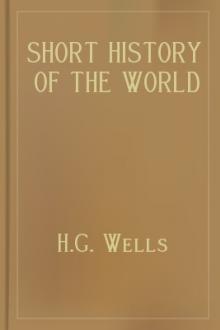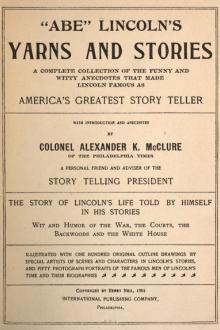A Short History of the World, H. G. Wells [beach books .TXT] 📗

- Author: H. G. Wells
- Performer: -
Book online «A Short History of the World, H. G. Wells [beach books .TXT] 📗». Author H. G. Wells
Before 1840, English settlements had already begun in New Zealand, and a New Zealand Land Company had been formed to exploit the possibilities of the island. In 1840 New Zealand also was added to the colonial possessions of the British Crown.
Canada, as we have noted, was the first of the British possessions to respond richly to the new economic possibilities that the new methods of transport were opening. Presently the republics of South America, and particularly the Argentine Republic, began to feel in their cattle trade and coffee growing the increased nearness of the European market. Hitherto the chief commodities that had attracted the European powers into unsettled and barbaric regions had been gold or other metals, spices, ivory, or slaves. But in the latter quarter of the nineteenth century the increase of the European populations was obliging their governments to look abroad for staple foods; and the growth of scientific industrialism was creating a demand for new raw materials, fats and greases of every kind, rubber, and other hitherto disregarded substances. It was plain that Great Britain and Holland and Portugal were reaping a great and growing commercial advantage from their very considerable control of tropical and sub-tropical products. After 1871 Germany, and presently France and later Italy, began to look for unannexed raw-material areas, or for Oriental countries capable of profitable modernization.
So began a fresh scramble all over the world, except in the American region where the Monroe Doctrine now barred such adventures, for politically unprotected lands.
Close to Europe was the continent of Africa, full of vaguely known possibilities. In 1850 it was a continent of black mystery; only Egypt and the coast were known. Here we have no space to tell the amazing story of the explorers and adventurers who first pierced the African darkness, and of the political agents, administrators, traders, settlers and scientific men who followed in their track. Wonderful races of men like the pygmies, strange beasts like the okapi, marvellous fruits and flowers and insects, terrible diseases, astounding scenery of forest and mountain, enormous inland seas and gigantic rivers and cascades were revealed; a whole new world. Even remains (at Zimbabwe) of some unrecorded and vanished civilization, the southward enterprise of an early people, were discovered. Into this new world came the Europeans, and found the rifle already there in the hands of the Arab slave-traders, and negro life in disorder.
By 1900, in half a century, all Africa was mapped, explored, estimated and divided between the European powers. Little heed was given to the welfare of the natives in this scramble. The Arab slaver was indeed curbed rather than expelled, but the greed for rubber, which was a wild product collected under compulsion by the natives in the Belgian Congo, a greed exacerbated by the clash of inexperienced European administrators with the native population, led to horrible atrocities. No European power has perfectly clean hands in this matter.
We cannot tell here in any detail how Great Britain got possession of Egypt in 1883 and remained there in spite of the fact that Egypt was technically a part of the Turkish Empire, nor how nearly this scramble led to war between France and Great Britain in 1898, when a certain Colonel Marchand, crossing Central Africa from the west coast, tried at Fashoda to seize the Upper Nile.
Nor can we tell how the British Government first let the Boers, or Dutch settlers, of the Orange River district and the Transvaal set up independent republics in the inland parts of South Africa, and then repented and annexed the Transvaal Republic in 1877; nor how the Transvaal Boers fought for freedom and won it after the battle of Majuba Hill (1881). Majuba Hill was made to rankle in the memory of the English people by a persistent press campaign. A war with both republics broke out in 1899, a three years’ war enormously costly to the British people, which ended at last in the surrender of the two republics.
Their period of subjugation was a brief one. In 1907, after the downfall of the imperialist government which had conquered them, the Liberals took the South African problem in hand, and these former republics became free and fairly willing associates with Cape Colony and Natal in a Confederation of all the states of South Africa as one self- governing republic under the British Crown.
In a quarter of a century the partition of Africa was completed. There remained unannexed three comparatively small countries: Liberia, a settlement of liberated negro slaves on the west coast; Morocco, under a Moslem Sultan; and Abyssinia, a barbaric country, with an ancient and peculiar form of Christianity, which had successfully maintained its independence against Italy at the battle of Adowa in 1896.
IT is difficult to believe that any large number of people really accepted this headlong painting of the map of Africa in European colours as a permanent new settlement of the worlds affairs, but it is the duty of the historian to record that it was so accepted. There was but a shallow historical background to the European mind in the nineteenth century, and no habit of penetrating criticism. The quite temporary advantages that the mechanical revolution in the west had given the Europeans over the rest of the old world were regarded by people, blankly ignorant of such events as the great Mongol conquests, as evidences of a permanent and assured European leadership of mankind. They had no sense of the transferability of science and its fruits. They did not realize that Chinamen and Indians could carry on the work of research as ably as Frenchmen or Englishmen. They believed that there was some innate intellectual drive in the west, and some innate indolence and conservatism in the east, that assured the Europeans a world predominance for ever.
The consequence of this infatuation was that the various European foreign offices set themselves not merely to scramble with the British for the savage and undeveloped regions of the world’s surface, but also to carve up the populous and civilized countries of Asia as though these people also were no more than raw material for exploitation. The inwardly precarious but outwardly splendid imperialism of the British ruling class in India, and the extensive and profitable possessions of the Dutch in the East Indies, filled the rival Great Powers with dreams of similar glories in Persia, in the disintegrating Ottoman Empire, and in Further India, China and Japan.
In 1898 Germany seized Kiau Chau in China. Britain responded by seizing Wei-hai-wei, and the next year the Russians took possession of Port Arthur. A flame of hatred for the Europeans swept through China. There were massacres of Europeans and Christian converts, and in 1900 an attack upon and siege of the European legations in Pekin. A combined force of Europeans made a punitive expedition to Pekin, rescued the legations, and stole an enormous amount of valuable property. The Russians then seized Manchuria, and in 1904, the British invaded Tibet....
But now a new Power appeared in the struggle of the Great Powers, Japan. Hitherto Japan has played but a small part in this history; her secluded civilization has not contributed very largely to the general shaping of human destinies; she has received much, but she has given little. The Japanese proper are of the Mongolian race. Their civilization, their writing and their literary and artistic traditions are derived from the Chinese. Their history is an interesting and romantic one; they developed a feudal system and a system of chivalry in the earlier centuries of the Christian era; their attacks upon Korea and China are an Eastern equivalent of the English wars in France. Japan was first brought into contact with Europe in the sixteenth century; in 1542 some Portuguese reached it in a Chinese junk, and in 1549 a Jesuit missionary, Francis Xavier, began his teaching there. For a time Japan welcomed European intercourse, and the Christian missionaries made a great number of converts. A certain William Adams became the most trusted European adviser of the Japanese, and showed them how to build big ships. There were voyages in Japanese-built ships to India and Peru. Then arose complicated quarrels between the Spanish Dominicans, the Portuguese Jesuits, and the English and Dutch Protestants, each warning the Japanese against the political designs of the others. The Jesuits, in a phase of ascendancy, persecuted and insulted the Buddhists with great acrimony. In the end the Japanese came to the conclusion that the Europeans were an intolerable nuisance, and that Catholic Christianity in particular was a mere cloak for the political dreams of the Pope and the Spanish monarchy—already in possession of the Philippine Islands; there was a great persecution of the Christians, and in 1638 Japan was absolutely closed to Europeans, and remained closed for over 200 years. During those two centuries the Japanese were as completely cut off from the rest of the world as though they lived upon another planet. It was forbidden to build any ship larger than a mere coasting boat. No Japanese could go abroad, and no European enter the country.
(In the Victoria and Albert Museum)
For two centuries Japan remained outside the main current of history. She lived on in a state of picturesque feudalism in which about five per cent of the population, the samurai, or fighting men, and the nobles and their families, tyrannized without restraint over the rest of the population. Meanwhile the great world outside went on to wider visions and new powers. Strange shipping became more frequent, passing the Japanese headlands; sometimes ships were wrecked and sailors brought ashore. Through the Dutch settlement in the island of Deshima, their one link with the outer universe, came warnings that Japan was not keeping pace with the power of the Western world. In 1837 a ship sailed into Yedo Bay flying a strange flag of stripes and stars, and carrying some Japanese sailors she had picked up far adrift in the Pacific. She was driven off by cannon shot. This flag presently reappeared on other ships. One in 1849 came to demand the liberation of eighteen shipwrecked American sailors. Then in 1853 came four American warships under Commodore Perry, and refused to be driven away. He lay at anchor in forbidden waters, and sent messages to the two rulers who at that time shared the control of Japan. In 1854 he returned with ten ships, amazing ships propelled by steam, and equipped with big guns, and he made proposals for trade and intercourse that the Japanese had no





Comments (0)